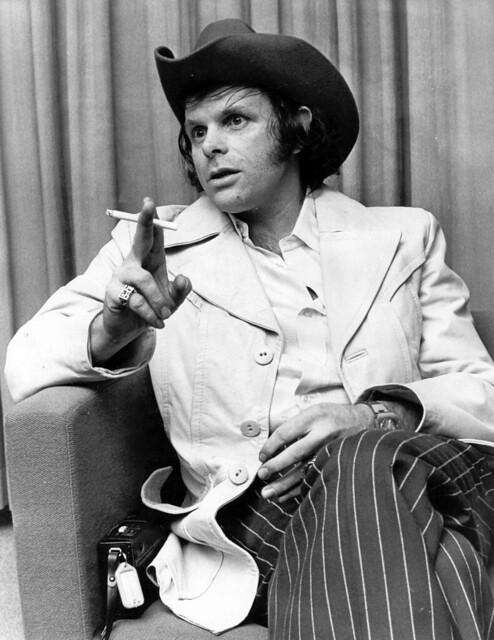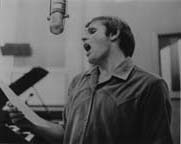
Del Shannon 15th February 1974, Australia
Del Shannon was one of the greats in rock music - singer, songwriter and brilliant guitarist. Never seemed to get his just deserts in this life.
Del Shannon was one of few singers in the early 60's "manufactured pop star" era who really had the talent.  An untrained voice with an incredibly high range, he had a piercing falsetto that would bring chills down your spine. "His voice was like a siren," noted Heartbreaker's guitarist Mike Campbell. As a guitarist, Shannon was considered legendary by music buffs in the industry and his fellow contemporaries alike. Dire Straits' Mark Knopfler admits that "Del Shannon was the reason I picked up my first guitar." Although remembered as "the man who sang 'Runaway'," his excellent guitar work was often overlooked. Shannon's greatest strength lied with songwriting. Anguish, misery, despair, and vulnerablility were his songwriting partners.
An untrained voice with an incredibly high range, he had a piercing falsetto that would bring chills down your spine. "His voice was like a siren," noted Heartbreaker's guitarist Mike Campbell. As a guitarist, Shannon was considered legendary by music buffs in the industry and his fellow contemporaries alike. Dire Straits' Mark Knopfler admits that "Del Shannon was the reason I picked up my first guitar." Although remembered as "the man who sang 'Runaway'," his excellent guitar work was often overlooked. Shannon's greatest strength lied with songwriting. Anguish, misery, despair, and vulnerablility were his songwriting partners.
 An untrained voice with an incredibly high range, he had a piercing falsetto that would bring chills down your spine. "His voice was like a siren," noted Heartbreaker's guitarist Mike Campbell. As a guitarist, Shannon was considered legendary by music buffs in the industry and his fellow contemporaries alike. Dire Straits' Mark Knopfler admits that "Del Shannon was the reason I picked up my first guitar." Although remembered as "the man who sang 'Runaway'," his excellent guitar work was often overlooked. Shannon's greatest strength lied with songwriting. Anguish, misery, despair, and vulnerablility were his songwriting partners.
An untrained voice with an incredibly high range, he had a piercing falsetto that would bring chills down your spine. "His voice was like a siren," noted Heartbreaker's guitarist Mike Campbell. As a guitarist, Shannon was considered legendary by music buffs in the industry and his fellow contemporaries alike. Dire Straits' Mark Knopfler admits that "Del Shannon was the reason I picked up my first guitar." Although remembered as "the man who sang 'Runaway'," his excellent guitar work was often overlooked. Shannon's greatest strength lied with songwriting. Anguish, misery, despair, and vulnerablility were his songwriting partners. SEA OF LOVE... DEL SHANNON
http://www.youtube.com/watch?v=11ZfttmRTtg
That voice has now been silenced. Shannon is another casualty in the hidden war against artists.
Del Shannon – real name Charles Westover – was an American rock legend from the ’60s whose hit songs included “Runaway,” “Keep Searching (We’ll Follow The Sun),” “Little Town Flirt” and “Do You Want to Dance?” Shannon taught himself to play guitar at age 13 by listening to country-western singers on radio. By 27, he wrote the innovative song “Runaway” while working at a carpet store and recorded it on an old reel-to-reel tape recorder. “The chord progressions, the drum lines, the falsetto – the whole thing was full of unorthodox ideas,” says Max Cook, the musician who recorded this with Shannon at the time. A professional recording of the song was done on January 21, 1961. By April 1, the song was number one in the nation. It would go on to become number one in 21 countries, and more than 200 artists, including Elvis Presley and Bonnie Raitt, would later cut versions of it.
Shannon would later say, “The screaming kids... when I got to number one, Lord, the fear was so great. I wanted to go back to Coopersville where I was picking strawberries. I said, ’What am I doing here?’” Alcohol would become his close friend, as Shannon described to the Los Angeles Times in 1987: “I hated the taste of booze, but I liked where it took me – into oblivion.”
After his initial success, musical tastes changed and his career declined in America, though he still enjoyed success as an artist and performer in England. Continuing to work in the music industry as a producer, he revived his singing career in the ’80s with an album produced by Tom Petty called “Drop Down and Get Me.” His cover version of “Sea of Love” rose to number 31 on Billboard’s national charts.
By 1990, he was well on his way to making a comeback, including scheduled tours in Australia, Canada, England and Japan. He was rumored to be chosen to become the late Roy Orbison’s replacement in the Traveling Wilburys with Petty, Jeff Lynne, Bob Dylan and George Harrison.
However, the powerful psychiatric drug Prozac, which WHO magazine described as the drug “thought by some to have a darker side” would bring his renewed hopes and dreams of a revitalized career to an abrupt end.
Unlike many other performers, Shannon organized all of the scheduling of his shows, a stressful task considering he was planning a European tour. He’d recorded a new song which he believed destined to be a hit and was preparing for this. At the same time he and his wife LeAnne were moving to a new house and taxes were due: He was the artist, the manager, the booking agent – everything. In addition, Shannon had contracted a serious sinus infection that he couldn’t shake, and he’d been dieting. He consulted a psychiatrist in January of 1990 and returned home to tell LeAnne, “Look what I’ve got. It’s not really a drug, it’s a chemical. It’ll help me over the hump I’m in.” The “chemical” was Prozac.
It appears it didn’t take long for the “darker side” of the drug to have a devastating effect on Shannon’s life. LeAnne knew immediately that something was terribly wrong. He couldn’t eat and lost too much weight. He didn’t want to go to England. He didn’t want to compose or play music. He didn’t want to do anything. “I watched him turn into somebody who was agitated, pacing, had trembling hands, insomnia and couldn’t function.” These symptoms can be attributed to known side effects of the drug, which include suicidal tendencies.
On February 8, 1990, Charles Westover shot himself in the head with a .22 caliber rifle. With him died the hopes, dreams and artistry of Del Shannon. According to LeAnne, her husband was “a well-informed and physically healthy man and father, [who] died violently after taking Prozac for only 15 days.”
Del Shannon’s voice has been silenced — another casualty in psychiatry’s hidden war against artists?
"His voice is like a siren,” Mike Campbell (lead guitarist for Tom Petty) said. “There is only one voice that does that sound, and that is Del Shannon’s.”That voice has now been silenced. Shannon is another casualty in the hidden war against artists.
Del Shannon – real name Charles Westover – was an American rock legend from the ’60s whose hit songs included “Runaway,” “Keep Searching (We’ll Follow The Sun),” “Little Town Flirt” and “Do You Want to Dance?” Shannon taught himself to play guitar at age 13 by listening to country-western singers on radio. By 27, he wrote the innovative song “Runaway” while working at a carpet store and recorded it on an old reel-to-reel tape recorder. “The chord progressions, the drum lines, the falsetto – the whole thing was full of unorthodox ideas,” says Max Cook, the musician who recorded this with Shannon at the time. A professional recording of the song was done on January 21, 1961. By April 1, the song was number one in the nation. It would go on to become number one in 21 countries, and more than 200 artists, including Elvis Presley and Bonnie Raitt, would later cut versions of it.
Shannon would later say, “The screaming kids... when I got to number one, Lord, the fear was so great. I wanted to go back to Coopersville where I was picking strawberries. I said, ’What am I doing here?’” Alcohol would become his close friend, as Shannon described to the Los Angeles Times in 1987: “I hated the taste of booze, but I liked where it took me – into oblivion.”
After his initial success, musical tastes changed and his career declined in America, though he still enjoyed success as an artist and performer in England. Continuing to work in the music industry as a producer, he revived his singing career in the ’80s with an album produced by Tom Petty called “Drop Down and Get Me.” His cover version of “Sea of Love” rose to number 31 on Billboard’s national charts.
By 1990, he was well on his way to making a comeback, including scheduled tours in Australia, Canada, England and Japan. He was rumored to be chosen to become the late Roy Orbison’s replacement in the Traveling Wilburys with Petty, Jeff Lynne, Bob Dylan and George Harrison.
However, the powerful psychiatric drug Prozac, which WHO magazine described as the drug “thought by some to have a darker side” would bring his renewed hopes and dreams of a revitalized career to an abrupt end.
Unlike many other performers, Shannon organized all of the scheduling of his shows, a stressful task considering he was planning a European tour. He’d recorded a new song which he believed destined to be a hit and was preparing for this. At the same time he and his wife LeAnne were moving to a new house and taxes were due: He was the artist, the manager, the booking agent – everything. In addition, Shannon had contracted a serious sinus infection that he couldn’t shake, and he’d been dieting. He consulted a psychiatrist in January of 1990 and returned home to tell LeAnne, “Look what I’ve got. It’s not really a drug, it’s a chemical. It’ll help me over the hump I’m in.” The “chemical” was Prozac.
It appears it didn’t take long for the “darker side” of the drug to have a devastating effect on Shannon’s life. LeAnne knew immediately that something was terribly wrong. He couldn’t eat and lost too much weight. He didn’t want to go to England. He didn’t want to compose or play music. He didn’t want to do anything. “I watched him turn into somebody who was agitated, pacing, had trembling hands, insomnia and couldn’t function.” These symptoms can be attributed to known side effects of the drug, which include suicidal tendencies.
On February 8, 1990, Charles Westover shot himself in the head with a .22 caliber rifle. With him died the hopes, dreams and artistry of Del Shannon. According to LeAnne, her husband was “a well-informed and physically healthy man and father, [who] died violently after taking Prozac for only 15 days.”
No comments:
Post a Comment